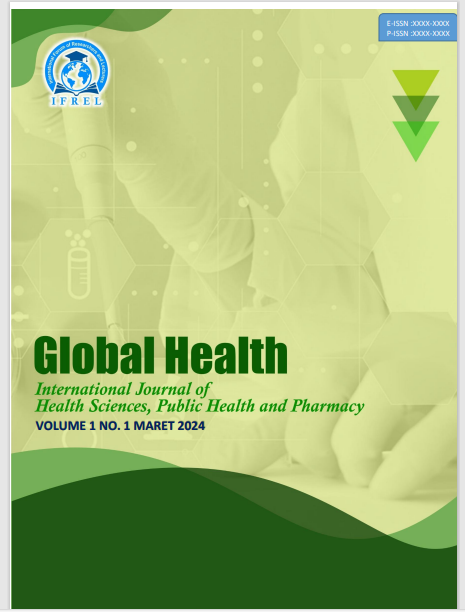The Relationship Between High Sodium and Potassium Con-sumption Patterns and the Incidence of Hypertension at the Community Health Center (UPT Puskesmas) in Bantaeng Re-gency
DOI:
https://doi.org/10.70062/globalhealth.v2i3.212Keywords:
Community health, Dietary patterns, Hypertension, Potassium, SodiumAbstract
A high-sodium and low-potassium consumption pattern can increase the risk of hypertension. Excess sodium can cause fluid retention and increase blood volume, while potassium plays a role in regulating fluid balance and blood pressure. This study aims to determine the relationship between high-sodium and high-potassium consumption patterns and the incidence of hypertension at the City Community Health Center (UPT Puskesmas) in Bantaeng Regency. The research method used was quantitative analytic with a cross-sectional study approach. The study population was all 278 patients visiting the City Community Health Center (UPT Puskesmas) in Bantaeng Regency. The sample size was 74 residents of the community at the City Community Health Center (UPT Puskesmas). Purposive sampling was used. The research instrument used was a questionnaire, which was distributed to respondents. The Food Frequency Questionnaire (FFQ) was used for sodium and potassium consumption. The results showed a relationship between sodium consumption and the incidence of hypertension (p=0.003 meaning Ha was accepted.The results showed a relationship between potassium consumption and the incidence of hypertension (p=0.001) meaning Ha was accepted. Researchers hope that this research can be used as a support or source of information to develop knowledge in the field of community health, especially in nursing, related to sodium and potassium consumption in reducing blood pressure in hypertension patients.
References
Andy. (2023). The relationship between age, length of time, sodium and potassium intake with the incidence of hyper-tension in fishermen in Blimbing Village, Paciran Lamongan. Media Gizi Kesmas, 12(2), 827–832. https://doi.org/10.20473/mgk.v12i2.2023.827-832
Agnesia. (2020). Risk factors for hypertension in the community in Kabongan Kidul Village, Rembang Regency. Journal of Young Medical Media.
Alfian. (2022). Differences in risk factors for hypertension in urban and rural communities in Bergas District. Journal (PDF).
August. (2020). The effect of family support on blood pressure control behavior in hypertensive patients at the Sumbang Health Center. Journal, 5(2). ISSN 5578-5582.
Land. (2020). The relationship between family support and the readiness of families suffering from hypertension at the Tabongo Health Center, Gorontalo Regency. Olive Journal, Muhammadiyah University of Gorontalo. ISSN 2301-5691.
Brunner. (2020). Nursing textbook. Jakarta: EGC.
Dwi. (2020). Hypertension in the community in the work area of the Harapan Raya Health Center Pekanbaru. Journal of Applied Science and Technology: Research of Applied Science and Education, 12(1), 64–77. ISSN 1979-9292.
Diana. (2021). The relationship between knowledge level and sodium consumption patterns with blood pressure in hypertensive patients in the working area of the Cempaka Health Center. Journal of Health Sciences Healthy Persons, 9(2). ISSN 2807-2693.
Deasy. (2023). The relationship between high sodium and potassium food consumption habits and blood pressure in the elderly. Proceedings of the Public Health Seminar, 1(Pre-Seminar).
Erica. (2022). Increasing knowledge about hypertension to improve blood pressure in young people in Japanan Hamlet, Margodadi, Sayegan, Sleman, Yogyakarta. Journal of Community Service, 3(1).
Firman. (2024). The relationship between sodium/salt consumption and hypertension status: A cross-sectional study in Makassar City. Multidisciplinary Journal of Education, Economics and Culture, 2(1), 43–49. https://doi.org/10.61231/mjeec.v2i1.234
Fitri. (2022). The relationship between sodium consumption and physical activity with the incidence of hypertension in coastal communities of Lemo-Lemo Environment, Bombana Regency. Journal of Scientific Nutrition (JGI), 9(2), 64–77. ISSN 2407-5515, E-ISSN 2745-990X.
Hidayat, A. (2020). Research procedures and data engineering analysis. Yogyakarta: Rihana Library.
Jumriani. (2023). Determinants of hypertension incidence in Posbindu visitors in the working area of the Ballaparang Health Center, Makassar City. National Journal of Health Sciences (JNIK), 1(3). Hasanuddin University. ISSN 2621-6507.
Ministry of Health, Republic of Indonesia. (2024). Health profile of the Ministry of Health of the Republic of Indonesia. Jakarta: Ministry of Health.
Lensi. (2022). Characteristic relationship with the incidence of hypertension in outpatients at dr. Doris Sylvanus Hospital, Central Kalimantan Province. Surya Medika Journal (JSM), 8(3), 176–186. https://doi.org/10.33084/jsm.v8i3.4511
Linggariana. (2023). Nursing care with foot soaking technique to lower blood pressure in hypertensive patients in Sri Pendowo Village, East Lampung. Journal of Community Service Creativity (PKM), 6(2). https://doi.org/10.33024/jkpm.v6i2.8126
Made. (2022). Overview of risk factors for hypertension in the community in the working area of the Dawan Health Center. Journal (PDF).
Nursalam. (2021). Community behavioral science. Jakarta: EGC.
Notoatmodjo. (2020). Public health sciences. Jakarta: Rineka Cipta.
Notoatmodjo. (2020). Health research methods. Jakarta: Rineka Cipta.
Oct. (2021). Family knowledge and support as risk factors for hypertension in coastal communities. Majority, 5(3).
Sangadah. (2022). The relationship between micronutrient intake (sodium, potassium, calcium, magnesium) and physical activity with the incidence of hypertension. Nutrizione (Nutrition Research and Development Journal), 2(3), 12–20.
World Health Organization. (2024). Prevalence of hypertension in the world and developing countries. Geneva: WHO.
Downloads
Published
How to Cite
Issue
Section
License
Copyright (c) 2025 Global Health: Journal of Health Sciences, Public Health and Pharmacy

This work is licensed under a Creative Commons Attribution-ShareAlike 4.0 International License.





